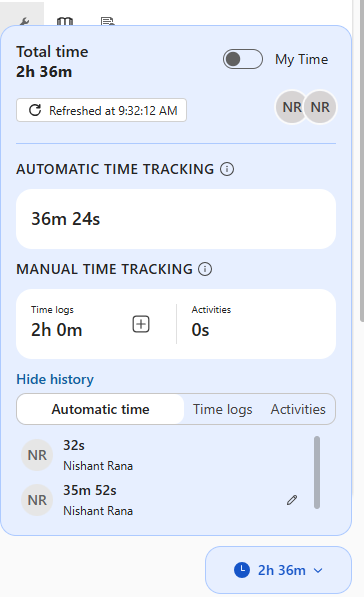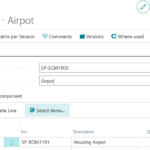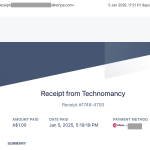Now Reading: Perth Panthers Blog 10: The Future of Field Service: Innovations from AI and IoT
-
01
Perth Panthers Blog 10: The Future of Field Service: Innovations from AI and IoT
- Home
- Dynamics 365
- Perth Panthers Blog 10: The Future of Field Service: Innovations from AI and IoT
Perth Panthers Blog 10: The Future of Field Service: Innovations from AI and IoT
 Mark ChristieDynamics 365, Dyn365CE, Dataverse2 months ago5 Views
Mark ChristieDynamics 365, Dyn365CE, Dataverse2 months ago5 Views
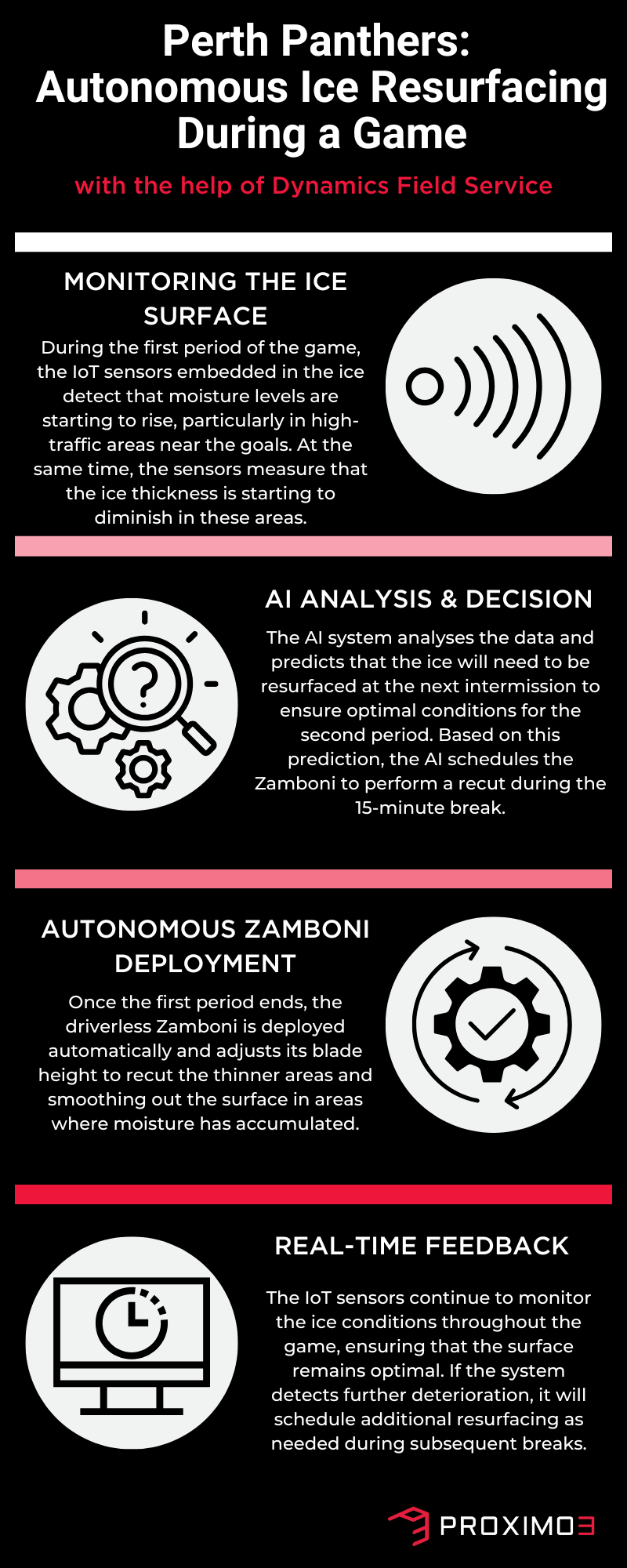
Perth Panthers Blog 10: The Future of Field Service: Innovations from AI and IoT
The Evolution of Field Service Technology
As field service technology continues to evolve, we are seeing the integration of artificial intelligence (AI), machine learning, and automation into everyday operations. These innovations are reshaping how businesses manage maintenance, scheduling, and equipment monitoring, enabling organisations to provide more proactive and predictive service. For industries like sports venue management, these advances are creating opportunities for more efficient operations, better resource allocation, and improved customer experiences.
For the Perth Panthers, the next wave of innovation could involve transforming how they manage their arena’s ice surface. By integrating AI, IoT sensors, and automation into their operations, the Panthers could introduce a driverless Zamboni that can automatically assess the condition of the ice and resurface it as needed—without human intervention. This technology could revolutionise ice maintenance, ensuring optimal conditions for every game and minimising the need for manual supervision.
The Problem: Manual Ice Resurfacing and Condition Monitoring
Currently, the Panthers rely on manual processes to determine when the ice needs to be resurfaced and to operate the Zamboni. While this system works, it comes with several challenges:
- Inconsistent Ice Quality: The timing of when the ice needs to be resurfaced can vary based on factors like temperature, humidity, and how much the ice has been used during the game or practice. Without real-time data, the operations team must rely on scheduled resurfacing or visual inspections, which can lead to uneven ice conditions.
- Manual Operation: The Zamboni requires a driver to manually operate the machine and ensure the ice is resurfaced properly. This not only increases labour costs but also leaves room for human error in how well the ice is maintained.
- Reactive Maintenance: Without real-time data on ice conditions, the operations team may only notice problems when they arise, leading to reactive maintenance. This can result in suboptimal ice conditions during games, potentially affecting player performance and safety.
- Time-Consuming Process: Manual resurfacing, coupled with the need to monitor ice conditions, can be time-consuming and may cause delays during games or events if additional cuts are required at short notice.
The Future: A Driverless Zamboni with AI and IoT Sensors
Imagine a future where the Perth Panthers use a driverless Zamboni equipped with AI and IoT sensors to manage ice resurfacing autonomously. This innovative system would continuously monitor the condition of the ice, assessing its moisture levels, thickness, and temperature. When the system detects that the ice needs to be resurfaced, it would automatically deploy the Zamboni to recut the ice, without requiring any manual intervention.
Here’s how this advanced technology could transform ice maintenance at the Enclosure:
- Real-Time Ice Condition Monitoring with IoT Sensors
IoT sensors embedded in the ice surface and around the arena could provide real-time data on key environmental conditions, such as:
- Moisture Levels: Sensors could detect moisture buildup on the ice, which may indicate that the surface is becoming too wet and slippery, making it necessary to resurface.
- Ice Thickness: Sensors could measure the thickness of the ice to ensure it remains within optimal parameters. If the ice becomes too thin due to wear or too thick due to accumulated layers of water, the system would know when to initiate a cut.
- Surface Temperature: Monitoring the temperature of the ice ensures that it remains cold enough for play. If the ice starts to warm up, the system would prompt the Zamboni to adjust the surface.
All of this data would be fed into Dynamics 365 Field Service, where AI-driven algorithms would analyse the data and determine when the ice needs to be resurfaced.
- AI-Driven Decision-Making for Ice Resurfacing
By integrating AI into the system, the Panthers can take the guesswork out of ice maintenance. Instead of relying on scheduled cuts or manual checks, the AI would analyse the data from the IoT sensors to make real-time decisions about when to resurface the ice. The AI would be able to:
Real-World Example – Preparing the Enclosure for Game Day:
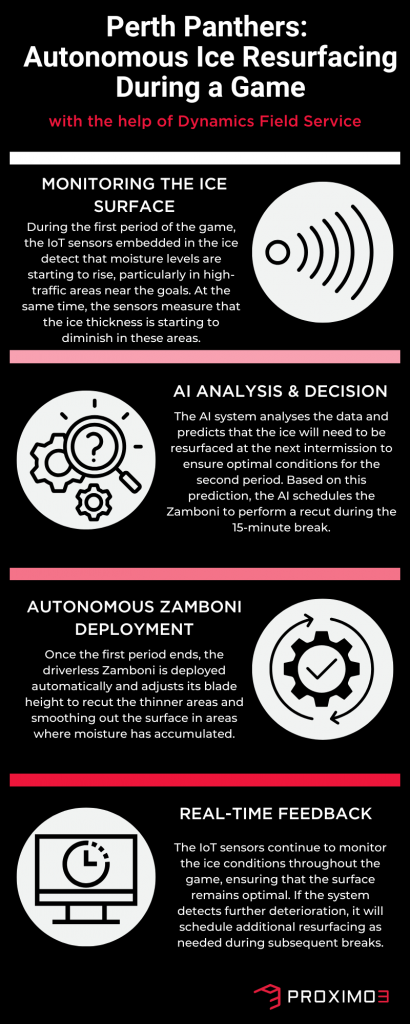
- Predict Ice Wear: Based on historical data and current conditions, the AI would predict when the ice is likely to degrade and preemptively schedule resurfacing, ensuring optimal conditions throughout the game or event.
- Optimise Resurfacing Timing: The AI would take into account factors such as upcoming game breaks, practice sessions, or intermissions to schedule resurfacing at the most convenient time, minimising disruption to the schedule.
- Driverless Zamboni Operations
The Zamboni itself would be fully automated, equipped with GPS and AI-powered navigation systems that allow it to operate autonomously. Here’s how this driverless Zamboni could work:
- Autonomous Navigation: Using pre-programmed routes and GPS data, the Zamboni would navigate around the ice autonomously, resurfacing the entire surface without the need for a human driver. The AI system would ensure the Zamboni follows the most efficient path, covering the ice uniformly.
- Adjusting to Ice Conditions: The Zamboni would adjust its resurfacing technique based on the real-time data from the IoT sensors. For example, if one section of the ice is wetter or thinner than the rest, the Zamboni would adjust its blade height and water distribution to target those areas more effectively.
- Automatic Deployment: When the AI system determines that the ice needs to be resurfaced, it would automatically deploy the Zamboni from its storage area. The machine would recut the ice and return to its charging station, all without human intervention.
Conclusion
The future of field service is bright, with innovations like AI, IoT, and autonomous systems poised to transform how arenas like the Enclosure are managed. The introduction of a driverless Zamboni, capable of monitoring ice conditions and resurfacing the ice without human intervention, represents a significant leap forward for the Perth Panthers. By embracing these emerging technologies, the Panthers can ensure that their arena remains at the cutting edge of performance and efficiency, delivering the best possible experience for players and fans alike.
As field service technology continues to evolve, the Perth Panthers are well-positioned to lead the way in arena innovation, creating a smarter, more automated future for ice hockey and sports venues.
Check Rachel McManus’s original post https://proximo3.com/perth-panthers-blog-10-field-service-and-ai/ on proximo3.com which was published 2024-12-04 10:13:00











